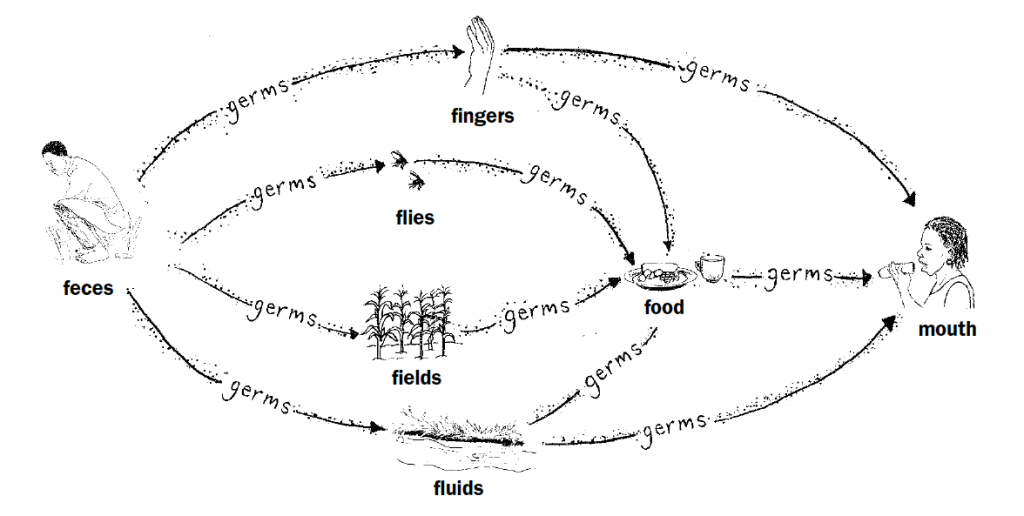Risk assessment is the process of quantifying the probability of a harmful effect to individuals or populations from the exposure to infectious agents (see also pathogens and contaminants). It includes the following four steps:
- hazard identification
- exposure assessment
- effect assessment (dose-response)
- risk characterisation
Sanitation systems should serve as a barrier (or a series of barriers) against the transmittance of different types of waterborne and excreta related pathogens in order to reduce health risk (see also health risk management and water sanitation and health).

The F-Diagram shows the faecal-oral transmission routes responsible for health risks. These routes may be amongst others be broken by adequate sanitary systems. Source: HESPERIAN FOUNDATION & UNDP (2004)
Sanitation and Cleanliness for a Healthy Environment
This book contains well-written information about both personal and public cleanliness including instructions on how to build safe toilets that respect the principles of sustainable Sanitation. The book is also available in Spanish and Creole.
HESPERIAN FOUNDATION ; UNDP (2004): Sanitation and Cleanliness for a Healthy Environment. Berkeley: The Hesperian Foundation URL [Accessed: 18.06.2019]Toilets That Make Compost
This book describes in an easy-to-understand and picture-based way how to construct three different low cost sanitation solutions, namely arborloos, fossa alterna and urine diversion toilets.
MORGAN, P. EcoSanRes (2007): Toilets That Make Compost . Stockholm: Stockholm Environment Institute URL [Accessed: 09.05.2019]Elimination of Micro-Organisms in Water Treatment
The main objective of this study was to develop a general strategy to assess elimination capacity of water treatment processes for pathogens.
HIJNEN, W.A.M. (2009): Elimination of Micro-Organisms in Water Treatment. Utrecht, The Netherlands: KWR Watercycle Research Institute URL [Accessed: 29.11.2012]Promoting Health, Well-Being and Human Security
In 2009–2010, events in the Americas brought into sharp focus the importance and the interconnectedness of health, security, and human well-being. The January 2010 earthquake in Haiti showed the tragic consequences of unplanned urban sprawl and the extreme vulnerability of populations living in poverty. Recalling these events, one understands that human security cannot be taken for granted; it must be protected and promoted.
PAHO (2010): Promoting Health, Well-Being and Human Security. Annual Report of the Director 2010. Pan American Health Organization (PAHO) URL [Accessed: 29.11.2012]How to Implement QMRA?
The goal of this text is to illustrate how Quantitative Microbial Risk Assessment (QMRA) can be undertaken in practice utilising case studies from the MicroRisk project. It outlines the data analysis strategies and describes the simulation methods using illustrative input and output data collected on selected Catchment-to-Tap Systems (CTSs). It is proposed that for each CTS/pathogen combination a full risk analysis involve 4 stages: Baseline QMRA, sensitivity analysis, hazardous events QMRA, and the use of QMRA results in risk management.
ROSER, D. PETTERSON, S. SIGNOR, R. ASHBOLT, N. NILSSON, P. THORWALDSDOTTER, R. (2006): How to Implement QMRA?. To Estimate Baseline and Hazardous Event Risks with Management End Uses in Mind. Sydney, Australia and Lund, Sweden: European Commission URL [Accessed: 29.11.2012]Guidelines for the safe use of wastewater excreta and greywater. Volume II. Wastewater Use in Agriculture
Volume II of the Guidelines for the safe use of wastewater, excreta and greywater provides information on the assessment and management of risks associated with microbial hazards and toxic chemicals. It explains requirements to promote the safe use of wastewater in agriculture, including minimum procedures and specific health-based targets, and how those requirements are intended to be used. It also describes the approaches used in deriving the guidelines, including health-based targets, and includes a substantive revision of approaches to ensuring microbial safety.
WHO (2006): Guidelines for the safe use of wastewater excreta and greywater. Volume II. Wastewater Use in Agriculture. Geneva: World Health Organisation URL [Accessed: 05.06.2019] PDF

